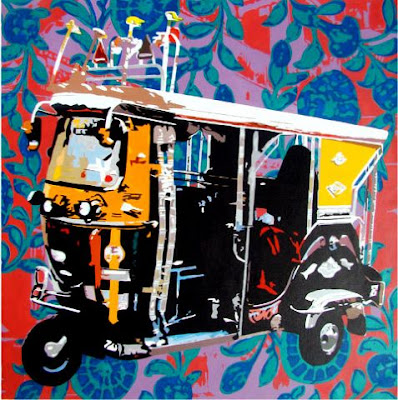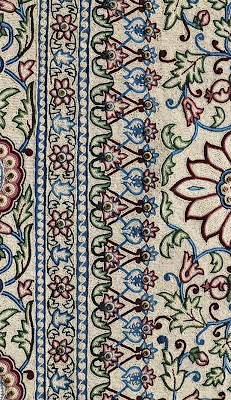




Exploring Contemporary Indian Art & More






| “The Skin Speaks a Language Not Its Own” by Bharti Kher |








KOLKATA: The entry of Indian and broader Asian art into the Southeast Asian region can only add to the vibrancy and diversity of the art scene.
Singapore Art Museum (SAM) director Kwok Kian Chow told ET that there has been a gradual increase in the number of galleries selling Indian art in Singapore. Together with staging successful Chinese art shows, SAM has also fielded a large exhibition of Indian art in 2007 featuring 40 "stunning" works.
"There are more and more galleries stocking and offering Indian art in Singapore. The Singapore Tyler Print Institute (STPI) has also invited contemporary Indian artists to work with them. SAM has also worked with various Indian institutions and collections to present shows on Indian art or exhibitions which incorporate Indian art under larger thematics," Mr Chow said in an email from Singapore.
According to him, Singapore Art Museum presented an Indian art exhibit, titled From the Everyday to the Imagined: An Exhibition of Indian Art, in 2007 which showcased 40 exquisite pieces. "This exhibition presented an ever-changing India, seen through the eyes of major stalwarts in the development of modern Indian art. The show featured creations by A Ramachandran, K G Subramanyan, Gulam Mohammed Sheikh, M F Husain, S H Raza and Arpana Caur. Here, visual perspectives of everyday social realities were juxtaposed against the rich tapestry of Indian mythology, tradition and fantasy. SAM had co-organised this exhibition with Seoul National University Museum of Art for it to travel to Korea," Mr Chow said.
"We understand from our Korean partner for the show that the Indian exhibition was a huge success. The show generated great attention from major media publications as well as the public," he added.
In Chow's view, a combination of factors are driving Indian art into the pan Southeast Asian region. "Firstly, there is the growing economic and geo-political significance of Asia in the 21st century. This includes, in particular, India and China. Secondly, there are also many affluent Indians or people of Indian descent (whether in India or outside India) who are now interested in their own heritage and this extends to collecting Indian art. But, I would say that the most important reason is the inspiration great civilisations for contemporary expressions. We are all in search of multiculturalism that extends into the distant past," he said.
The base of Indian art galleries in Singapore is expanding. There are a number of outstanding Indian art galleries in Singapore, Chow said. These include Gajah Gallery, Bodhi Art, Indigo Blue Art, The Gallery of Gnani Arts and Art Mosaic Gallery.
SAM, which harbours a repository of 7,000 works, sports in its collection 70 Indian paintings including those by Jogen Chowdhury, Sunil Das, Arpana Caur and Jamini Roy.
Despite the tremendous growth in Asian art prices in recent years, Indian artworks could still be much lower from the international perspective. "It is quite relative. Both Chinese and Indian art prices have increased fantastically at auctions over the last few years. However, it is true they have yet to reach the levels of some Western artists. This is to be expected as a large proportion of the art market is still centred in the US and Europe."
Business Standard (India)
22 April 2009
Kishore Singh
It isn’t just India’s politicians but its artists as well who refuse to let age come in the way of their constituency. At different points, different artists have been important not just from the point of view of art aesthetics, or value, but because of the pivotal role they have played in providing the stepping stones with which to monitor the key turns in Indian art. These must necessarily include Raja Ravi Varma less for his kitschy calendar pop-art and more for the fusion of Indian and European idioms that continues to dictate popular taste; the Tagore family for opening up the way art was viewed in India; Nandalal Bose, India’s first truly renaissance artist; and Amrita Sher-Gil for the passion she brought to the form in her very short life.
India's tryst with modern art traces its origins to roughly the turn of the last century up to India’s independence, and it is the “moderns” — as both the artists and their art is referred to — who define the popular perception of how we view art in this country. Among these, the most radical by far was F N Souza whose provocative drawings and paintings earned him a fair share of ire and more brickbats than bouquets, though it might be said in the same breath that his sensibility lent more towards European extremism than any obvious Indian sensibility.
Souza was a victim of his own excesses, but among those who once shared the platform with him are three painters who without doubt can be regarded as the greatest living artists of this country. Of them, S H Raza, has been referred to also as the greatest living artist of France, and while that might be arguable — his work is collected mostly by Indians — Raza, 87 years, has said that by the end of this year he would like to wind up his atelier in Paris and return to the country of his birth, to probably New Delhi, where he is in the process, with friend Ashok Vajpeyi, of searching for land to create an institution for the arts.
Raza’s record at a Saffronart auction is Rs 4.2 crore, which must seem formidable given that critics have savaged him for repeatedly painting variations of the Bindu and the Mandala, forms that set him apart from his peers, creating a visual language that is both abstract as well as rooted in the tradition of tantra. Raza’s prices have skittered and gained since 2000, and have consolidated after 2003, casting him as a blue-chip, even though critics — and collectors — say Raza’s paintings don’t compel you to want all of his important works since they seem to replicate each other.
India’s most maverick, most loved and equally hated artist is M F Husain, 94 years this August, who single-handedly broke the cordons of exclusivity and took his art mainstream to the masses. From travelling around the world in bare feet to creating a show of crumpled newspapers, he has mocked critics, courted moneyed buyers yet reached out to people, a bond he built as a hoarding artist painting posters for Bollywood marquees. Some of the most iconic images in Indian art have been created from his palette — Mother Teresa, Indira Gandhi, the Lady with the Lamp, vignettes from the Ramayana and the Mahabharata, and of course, his horses. In recent times it seems to be trendy to dismiss Husain’s prodigious talent, but make no mistake: Husain is India’s tour de force of art. Currently at home in Dubai, where he is creating a series on the Arabic civilisation, and in London, where he has a home, Husain has shied away from returning to India fearing for his life from Hindu fundamentalists who have objected to some of his paintings. His prices, always the bellwether index of the art world, have fallen recently, though he has struck the biggest deals for the largest sums of money that any Indian artist has commanded: a gimmicky Rs 100 crore for one such series in India, and an undisclosed sum for his work on the Arab civilisation, making him without a doubt India’s richest living artist.
One reason for the fall in Husain’s price is his proclivity to paint too much, too fast, the exact opposite of Mumbai-based Tyeb Mehta, 84 years, who refuses to let his debilitating health keep him from his canvas. If it appears that Mehta has painted very little, it is because of his tendency to ruthlessly destroy those works that don’t measure up to his critical gaze. In many ways, Mehta could be called minimalist: Since the seventies, his subjects have been mythological. He seems to enjoy scale, but what is most compelling is the energy on his canvases that is at once awesome and fearful. His price point has held steady for many years now, and even though Souza exceeded his auction high of Rs 8.2 crore in a surprise upset last year, there can be no doubt that Tyeb Mehta is not only India’s greatest living artist, his works are most likely to continue to escalate in value over the years.
Bangalore
Subject: Kynkyny Art Gallery presents- A Divine Encounter: a solo exhibition of artworks by Appanna Pujari, whose works have been inspired by traditional styles of Indian art.
At: 33/200, NS Iyengar Street, Off Railway Parallel Road, Nehrunagar Kumarapark.
Tel: 080-23449570.
End date: April 30
Delhi
Subject: An exhibition of paintings by Sanjib Saha.
At: Delhi 'O' Delhi Foyer, Habitat World, IHC, Lodhi Road.
Tel: 011-43663080.
End Date: April 30
Mumbai
Subject: A group show titled Art Route by artists Hemant Sonawane, Hemant Ravandale, Manoj Maurya, Nilesh Vede and Rakesh Pattnaik.
At: Prriya and Chintan Art Studio, Raghuvanshi Mills Compound, Senapati Bapat Marg, Lower Parel.
Tel: 022-30480083.
End Date: May 13
Chennai
Subject: The Forum Art Gallery presents Oh Hanuman- an exhibition of paintings and sculptures by various artists.
At: Forum Art Gallery, 57, 5th Street, Padmanabha Nagar, Adyar.
Tel: 044-42115596
End Date: April 24
Kolkata
Subject: Genesis Art Gallery presents Connoisseurs' Choice - an exhibition of paintings by various artists.
At: 8B Middleton Street.
Tel: 033-22293886.
End Date: April 30
The following article published last month emphasizes the enormity of the Indian art market.
The Statesman (India)
27 March 2009
The Financial Times Limited.
The Indian contemporary art and craft market was given a boost at an acution held by Osian's in Mumbai. The auction that was valued at lower estimate of approximately Rs 8.9 crore, fetched over Rs 8 crore. Of the 108 works offered, 71 found buyers, registering a sale of 66 per cent. While the average lot price registered for the full auction was Rs 11.42 lakh, the average lot price for modern art was Rs 21.5 lakh as against the average lot price of Rs 1.41 lakh for Indian contemporary craft, thereby registering a total sale of 57 per cent and 82 per cent respectively. An 'Untitled' mid-1930's work by Nicolas Roerich, the finest seen so far at any Indian auction, fetched the highest price at Rs 1.68 crore. Akbar Padamsee's brilliant Nude, a 1987 oil on canvas, sold for Rs 1.44 crore and Rameshwar Broota's Sewadar fetched Rs 1.14 crore.
Kalyan Joshi's Story of Pabuji, a Phad painting from Rajasthan that was awarded the National Merit Award in 2006 sold for Rs 9 lakh, 900 per cent more than its lower estimate. Sanjay Manubhai Chitara's, Mata Ni Pachedi work from Gujarat, titled Visat Mata, sold for Rs 4.5 lakh, 1,286 per cent more than its lower estimate.
